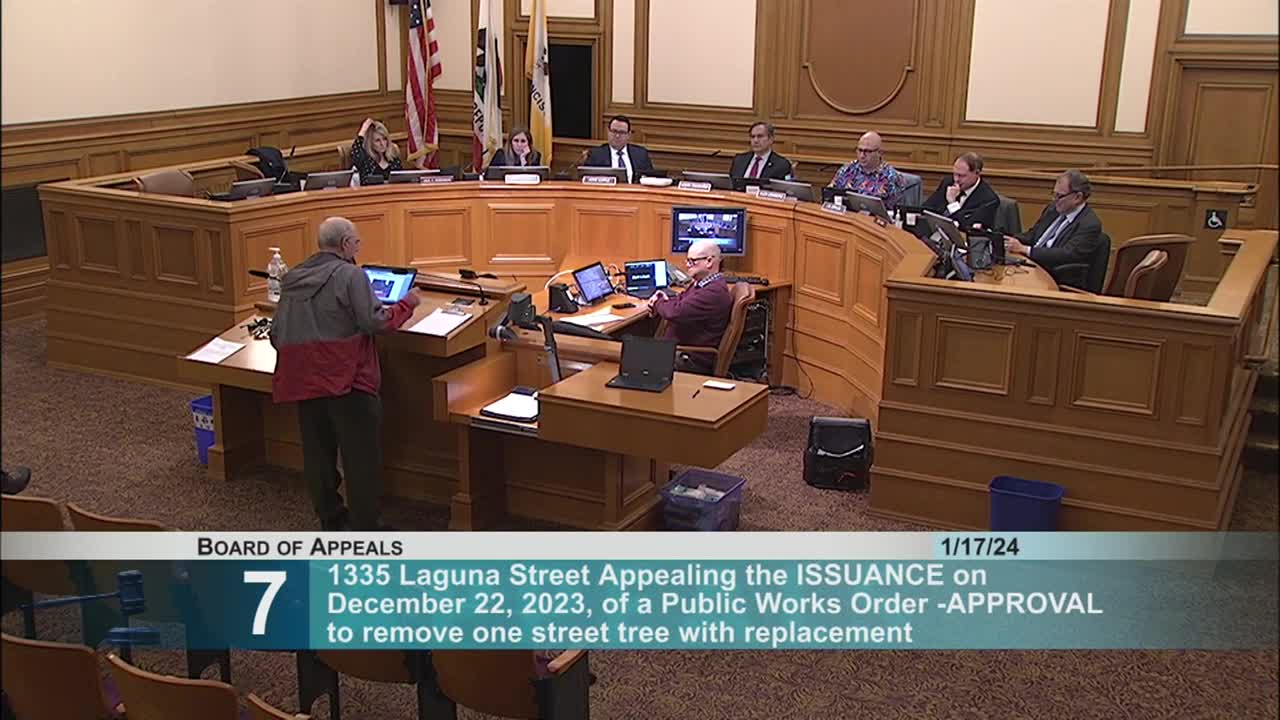Public Works Bureau defends removal of declining Brisbane box tree at Laguna Street
January 17, 2024 | San Francisco City, San Francisco County, California

This article was created by AI summarizing key points discussed. AI makes mistakes, so for full details and context, please refer to the video of the full meeting. Please report any errors so we can fix them. Report an error »

In a recent San Francisco government meeting, city officials discussed the contentious removal of a tree identified as a public safety hazard. The meeting highlighted a dispute over the identification and condition of the tree, which has sparked significant public interest and concern.
The focal point of the discussion was a small tree, a Brisbane box, proposed for removal due to its deteriorating health. Public Works representative Chris Buck emphasized that the tree has experienced severe dieback, with approximately 80% of its canopy dead and cracks forming in its trunk. Buck stated that the tree poses a potential hazard to public safety, justifying the city's decision to pursue its removal.
However, the meeting revealed confusion regarding the tree's identification. A local resident, Mr. Karnes, raised concerns about the accuracy of the tree's designation and numbering in the city’s database. He argued that the city had conflated the small tree with a larger, healthy tree, which he believed should not be removed. This misidentification has led to public outcry and calls for greater transparency in the city’s tree management practices.
Buck defended the department's record-keeping, asserting that there were no errors in the identification process. He acknowledged the importance of public feedback but maintained that the tree in question is indeed the one slated for removal. The discussion underscored the challenges faced by city officials in balancing public safety with community concerns over urban forestry management.
As the meeting concluded, it was clear that the city must navigate the complexities of tree management while addressing public apprehensions. The ongoing debate over this tree's fate reflects broader issues regarding urban forestry, public safety, and community engagement in San Francisco. Moving forward, city officials may need to enhance communication and transparency to rebuild trust with residents and ensure accurate data management in their urban forestry initiatives.
The focal point of the discussion was a small tree, a Brisbane box, proposed for removal due to its deteriorating health. Public Works representative Chris Buck emphasized that the tree has experienced severe dieback, with approximately 80% of its canopy dead and cracks forming in its trunk. Buck stated that the tree poses a potential hazard to public safety, justifying the city's decision to pursue its removal.
However, the meeting revealed confusion regarding the tree's identification. A local resident, Mr. Karnes, raised concerns about the accuracy of the tree's designation and numbering in the city’s database. He argued that the city had conflated the small tree with a larger, healthy tree, which he believed should not be removed. This misidentification has led to public outcry and calls for greater transparency in the city’s tree management practices.
Buck defended the department's record-keeping, asserting that there were no errors in the identification process. He acknowledged the importance of public feedback but maintained that the tree in question is indeed the one slated for removal. The discussion underscored the challenges faced by city officials in balancing public safety with community concerns over urban forestry management.
As the meeting concluded, it was clear that the city must navigate the complexities of tree management while addressing public apprehensions. The ongoing debate over this tree's fate reflects broader issues regarding urban forestry, public safety, and community engagement in San Francisco. Moving forward, city officials may need to enhance communication and transparency to rebuild trust with residents and ensure accurate data management in their urban forestry initiatives.
View full meeting
This article is based on a recent meeting—watch the full video and explore the complete transcript for deeper insights into the discussion.
View full meeting
